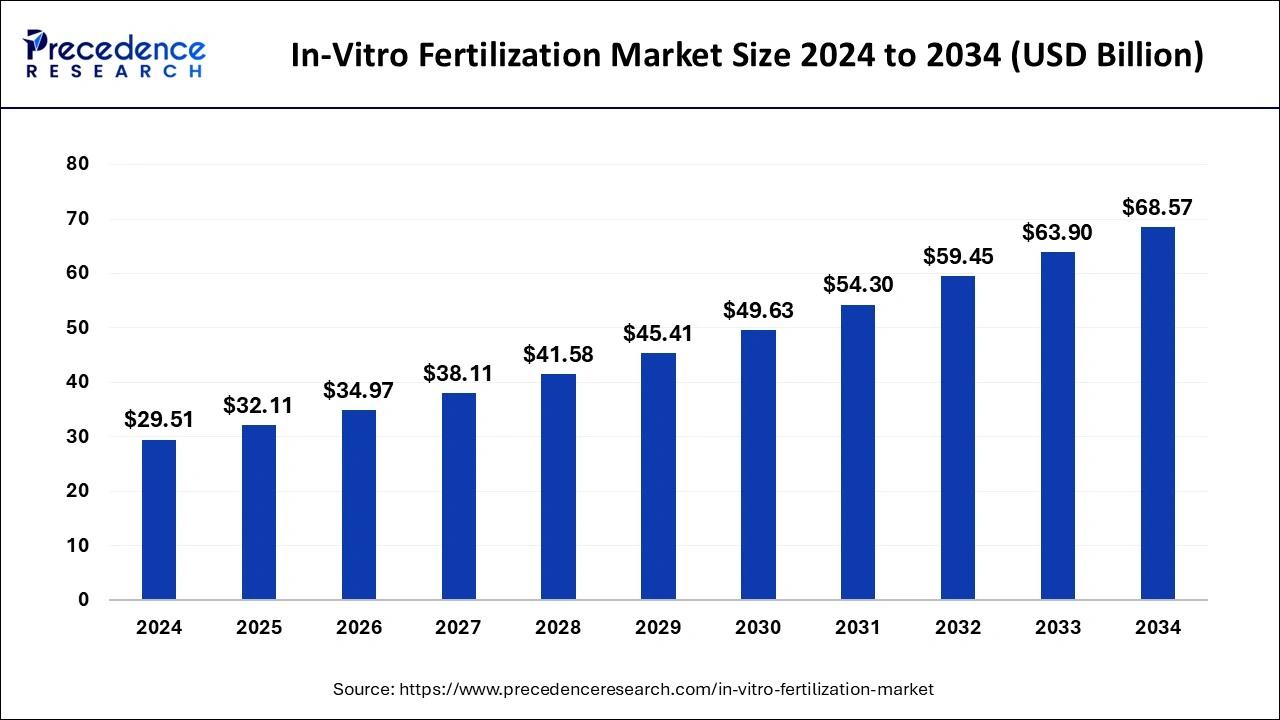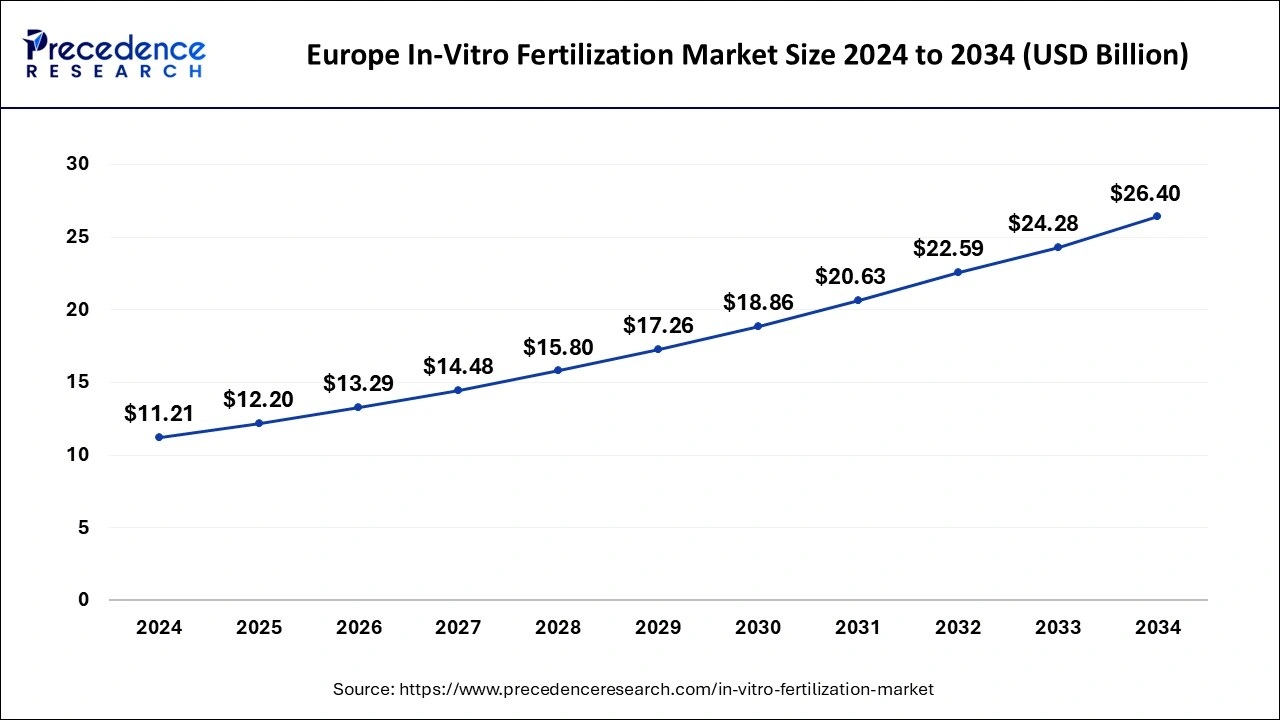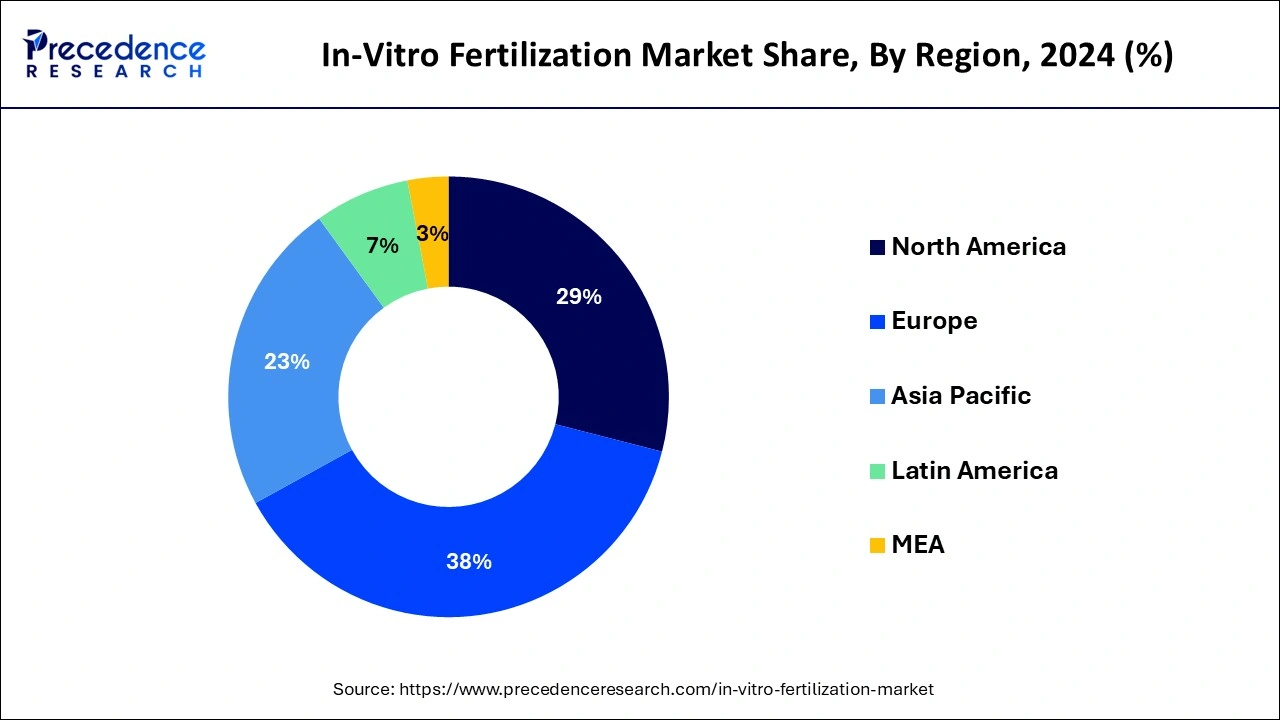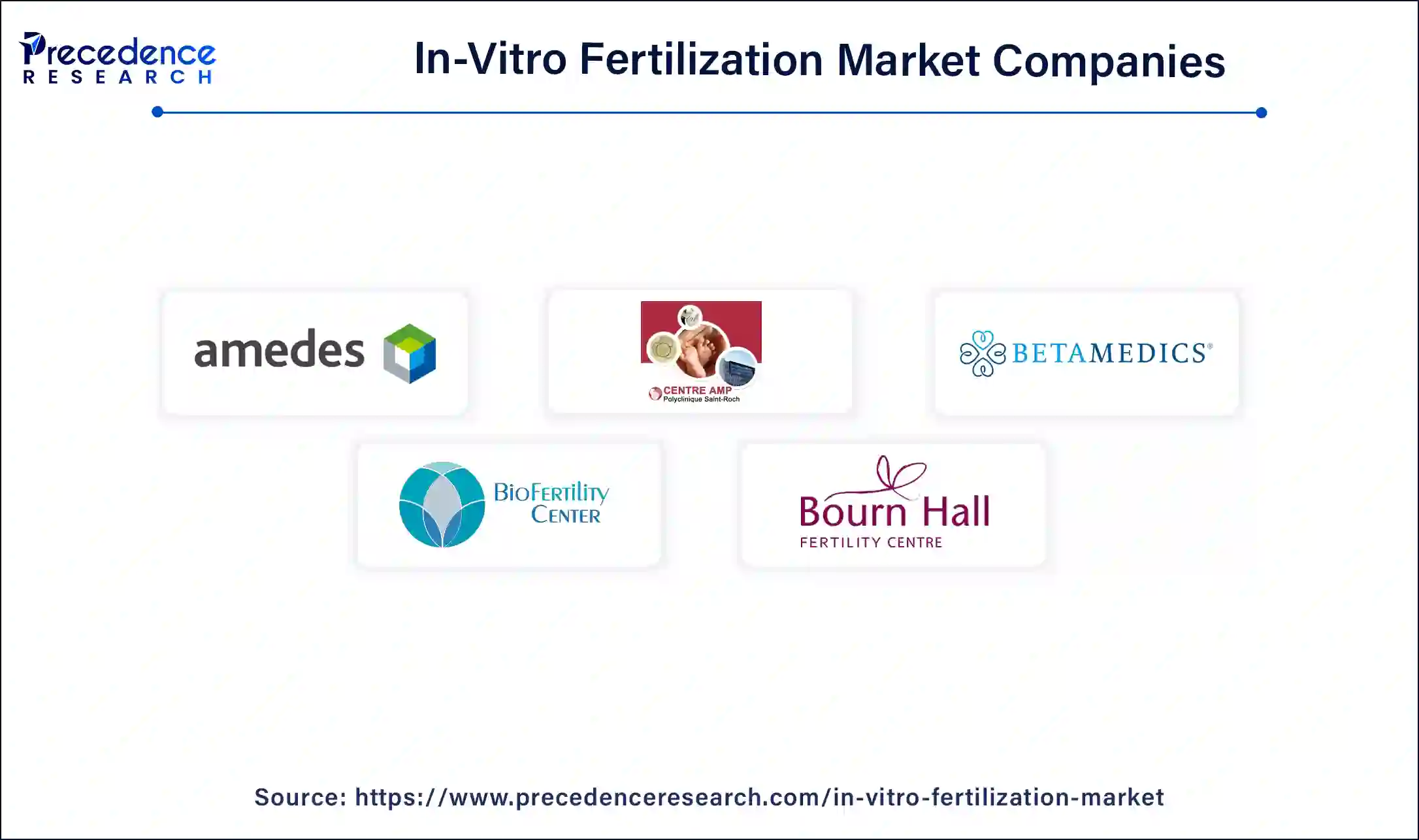September 2024
The global in-vitro fertilization market size is calculated at USD 32.11 billion in 2025 and is forecasted to reach around USD 68.57 billion by 2034, accelerating at a CAGR of 8.80% from 2025 to 2034. The Europe in-vitro fertilization market size surpassed USD 12.20 billion in 2025 and is expanding at a CAGR of 8.94% during the forecast period. The market sizing and forecasts are revenue-based (USD Million/Billion), with 2024 as the base year.
The global in-vitro fertilization market size was estimated at USD 29.51 billion in 2024 and is anticipated to reach around USD 68.57 billion by 2034, expanding at a CAGR of 8.80% from 2025 to 2034.

The Europe in-vitro fertilization market size was evaluated at USD 11.21 billion in 2024 and is predicted to be worth around USD 26.40 billion by 2034, rising at a CAGR of 8.94% from 2025 to 2034.

Europe dominated the global market with the largest market share of 38% in 2024. due to rising medical tourism and legal revisions related to IVF techniques.
Asia Pacific region is expected to witness remarkable CAGR during the forecast period. This is attributed to the presence of huge population, rapidly declining fertility rates, rising number of women focused government initiatives, growing preference for careers over family among women population, and increased awareness regarding the fertility clinics and procedures. The growing awareness among the population regarding the in-vitro fertilization, rising healthcare expenditure, and rising adoption of advanced reproductive technology in Asia Pacific are the prominent drivers of the in-vitro fertilization market. Furthermore, the rising medical tourism industry is anticipated to impact the growth of the in-vitro fertilization market in the region. The country like Japan and South Korea are facing declining rate of population owing to the rising median age of the first time mothers. Women in these countries are more concerned regarding their career and gives lesser importance over starting a family during their 20s. Therefore this results in delayed marriages and delayed pregnancies. Women over the age of 35 years have higher chances of miscarriage and stillbirth. Therefore, sometimes even after receiving the fertility treatment, the success rate is low due to the aging factor of the women. This factor may have negative impact on the market especially in countries like South Korea and Japan. Moreover, the population control policies of the Chinese government is expected to have a massive impact on the China in-vitro fertilization market.

North America is witnessing a significant decline in the fertility rates among both the men and women population. Moreover, the rising prevalence of polycystic ovary syndrome. The rising number of fertility clinics, improved reimbursement policies of the government pertaining to fertility issues, and increased healthcare expenditure are the major factors that drives the growth of the North America in-vitro fertilization market. Delayed marriage and pregnancy, rising obesity rates, and increased consumption of alcohol are the primary factors behind the surging infertility rates, which is expected to drive the North America in-vitro fertilization market.
The global in-vitro fertilization market is primarily driven by various factors such as rising male infertility, increasing in the median age of first time mothers, increasing obesity, declining fertility rates, and growing consumption of alcohol. Moreover, the rising awareness regarding the infertility coupled with the availability of advanced treatment options is fueling the demand for the in-vitro fertilization. The rising median age of the first time mothers is a significant growth driver. This is attributed to the rising number of women population prioritizing their education, work, and career. This results in late marriages. Moreover, the increased awareness regarding the contraceptives and its rising usage is another factor behind the increasing median age of the first time mothers. According to the Australian Institute of Health and Welfare, the median age of the first time mothers in Australia grew from 27.9 years to 31.9 years from 2009 to 2019. Therefore, the increasing average age of the first time mothers is one of the most significant factors that is estimated to propel the growth of the in-vitro fertilization market during the forecast period.
Delayed pregnancy after marriage is another crucial factor that drives the market growth. There has been a surge in the number of mothers who delays pregnancy even after the age of 35 years. The delayed pregnancies leads to complications in pregnancy, which gives rise to infertility and hence it drives the in-vitro market growth. Furthermore, the decline in fertility rates across the globe is contributing significantly to the growth of the market. According to the United Nations World Fertility Report 2019, a rapid decline in the fertility rate have been observed in around 77 countries across the globe. It was observed that the adolescent fertility rate decreased by over 50% between 1990 to 1995 and 2015 to 2020. As per the Hebrew University of Jerusalem, the sperm count in men have declined more than 50% in the last 40 years. Therefore, the rapidly declining fertility rates are the top contributors to the growth of the global in-vitro fertilization market.
| Report Coverage | Details |
| Market Size in 2025 | USD 59.45 Billion |
| Market Size by 2034 | USD 59.45 Billion |
| Growth Rate from 2025 to 2034 | CAGR of 9.10% |
| Largest Market | Europe |
| Base Year | 2024 |
| Forecast Period | 2025 to 2034 |
| Segments Covered | Product, End User, Region |
| Regions Covered | North America, Europe, Asia-Pacific, Latin America, and Middle East & Africa |
Based on the product type, the fresh non-donor segment dominated the market with revenue share in 2024. This is attributable to various factors such as high rate of success, higher birth rates as compared to that of frozen embryos, easy implantation, and the fresh embryo transfer results in better results. The higher adoption of the fresh non-donor cycle coupled with the rising infertility rates across the globe is the major driver of this segment. The increased popularity of this cycle is expected to sustain its dominance throughout the forecast period.
The frozen non-donor is expected to witness fastest growth segment during the forecast period. This is mainly attributed to the higher pregnancy rates along with the low cost. Frozen transfer is much easier for both the patients and the endocrinologists. Moreover, the level of stress on the physical and mental health of the women is less in the frozen non-donor cycle, which is expected of fuel the growth of this segment in the forthcoming years.
Based on the end user, the fertility clinics segment accounted largest revenue share in 2024. Fertility clinics are the first preference for the couples to diagnose their issues related with fertility. The fertility clinics are the specialized clinics that offers specialized care services to the couples and individuals related to their pregnancy and fertility problems. The increasing number of fertility clinics, increasing awareness regarding the fertility clinics, and declining fertility rates are the major factors that has fostered the growth of the fertility clinics segment across the globe.
Hospitals is estimated to be the most opportunistic segment during the forecast period. The wide spread penetration of the hospitals, developing healthcare infrastructure in developing nations, 24*7 presence of health professionals, and availability of advanced surgical tools and equipment in hospitals are the major factors that boosts the demand for the hospital services.

Key Market Developments
By Product Type
By End User
By Product
By Type
By Instrument
By Geography
For inquiries regarding discounts, bulk purchases, or customization requests, please contact us at sales@precedenceresearch.com
No cookie-cutter, only authentic analysis – take the 1st step to become a Precedence Research client
September 2024
February 2025
March 2025
January 2025